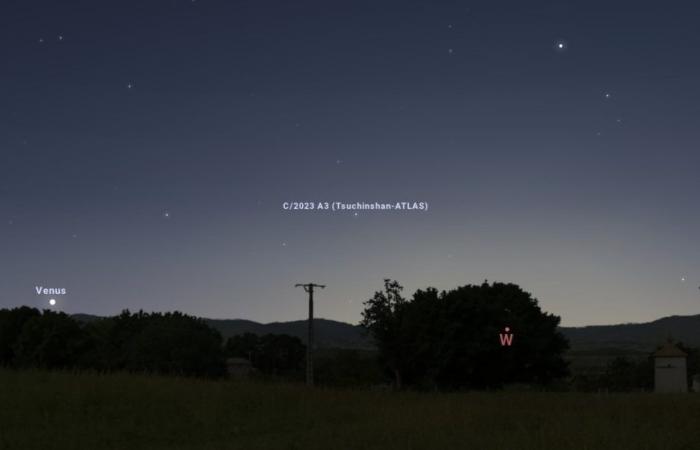The comet C/2023 A3 (Tsuchinshan-ATLAS) is a celestial object that arouses keen interest within the astronomical community. Discovered in January 2023 by the Purple Mountain Observatory (Tsuchinshan) in China and the ATLAS (Asteroid Terrestrial-impact Last Alert System) program in Hawaii, this comet could offer an exceptional spectacle in 2024 by becoming visible to the naked eye since the Earth.
The photo above was taken on 10/13/2024 in the Chartreuse massif near Grenoble.
Scientific data on comet Tsuchinshan-ATLAS
- Official designation : C/2023 A3 (Tsuchinshan-ATLAS)
- Date of discovery : January 2023
- Discoverers : Purple Mountain Observatory and ATLAS program
- Perihelion (passage closest to the Sun) : Planned for September 28, 2024
- Distance to perihelion : Environ 0.39 astronomical units (AU) of the Sun (1 AU ≈ 150 million km)
- Passage as close as possible to Earth : Environ 0.46 AUplanned for October 13, 2024
- Expected apparent magnitude : Could reach a magnitude of 0 to -1which would make it very bright and easily visible to the naked eye
- Origin : Probably from the Oort Cloud, a distant region of the solar system filled with long-period comets
When to observe the comet from Lyon?
The ideal period for observing comet Tsuchinshan-ATLAS from Lyon will be between September and November 2024 :
- End of September to beginning of October 2024 : Visible in the dawn sky, before sunrise, towards the east.
- Mid-October to November 2024 : Visible in the evening sky, after sunset, looking west.
Trajectory in the sky
- September 2024 : The comet will cross the constellations of Lion a you Sextant.
- October 2024 : It will move towards the constellations of the Virgin a you Bouvier.
- November 2024 : It will gradually move away, decreasing in brightness.
Methods to locate it
- Use astronomy apps : Free applications like Stellarium, SkySafari or Star Walk 2 allow you to track the position of celestial objects in real time based on your location.
- Consult the ephemeris : The ephemeris provides precise information on the position of the stars for each day. Sites like the IMCCE (Institute of Celestial Mechanics and Ephemeris Calculation) offer this data.
- Observe landmark constellations : Familiarize yourself with the constellations crossed by the comet to make it easier to spot.
- Participate in observation sessions : Join local astronomy clubs that organize collective observations.


Where to observe the comet in Lyon?
For optimal observation, move away from areas of high light pollution. Here are some recommended sites around Lyon:
- Mount Verdun : Located about 15 km northwest of Lyon, this highest point offers a clear horizon and less light pollution.
- The Col de la Luère : About 20 km west of Lyon, this pass is accessible and far from urban lights.
- The heights of the Monts du Lyonnais : Villages like Yzeron or Saint-André-la-Côte offer darker skies.
- Pilat Park : About 40 km south of Lyon, this regional natural park is ideal for astronomical observation.
- The Ain Plateau : Towards the east, beyond the Lyon metropolitan area, you will find rural areas suitable for observation.
Tips for a successful observation
- Choose the right time : The best viewing conditions are when the sky is darkest, that is, far from dusk and dawn.
- Avoid light pollution : Stay away from city lights to minimize their impact on the visibility of the comet.
- Consult the lunar phases : A night without a moon or with a faint moon is preferable.
- Prepare the equipment :
- To the naked eye : If the comet’s magnitude meets predictions, it will be visible without an instrument.
- Binoculars : They will improve visibility and make it possible to distinguish the tail and the coma of the comet.
- Telescope : For detailed observation, particularly of the nucleus.
- Vision adapter : Avoid direct light sources to allow your eyes to adapt to the dark (about 20 minutes).
- Check the weather : Clear skies are essential. Check the weather forecast before planning your outing.
Participate in astronomical events in Lyon
- Vaulx-en-Velin Planetarium : Offers sessions and workshops on astronomy. They could organize special events for comet viewing.
- Astronomical Society of Lyon : Regularly organizes observation evenings and conferences. This is an opportunity to benefit from the expertise of enthusiasts and to access professional equipment.
Understanding the Importance of Comet Tsuchinshan-ATLAS
- Scientific study : Comets are witnesses to the first moments of the solar system. Analyzing their composition allows us to better understand the formation of planets.
- Rare phenomenon : Comets visible to the naked eye are relatively rare. This is a unique opportunity for astronomy enthusiasts.
Precautions to take when observing
- Personal security : If you are going to isolated areas, inform a loved one of your destination and bring clothing suitable for nighttime conditions.
- Respect for the environment : Leave no trace of your passage. Respect nature and private property.
Comet Tsuchinshan-ATLAS promises to be one of the major astronomical events of 2024. By preparing now and choosing the best observation sites around Lyonyou will increase your chances of fully enjoying this celestial spectacle. Remember to stay informed with science updates, as predictions may change as the comet gets closer.








